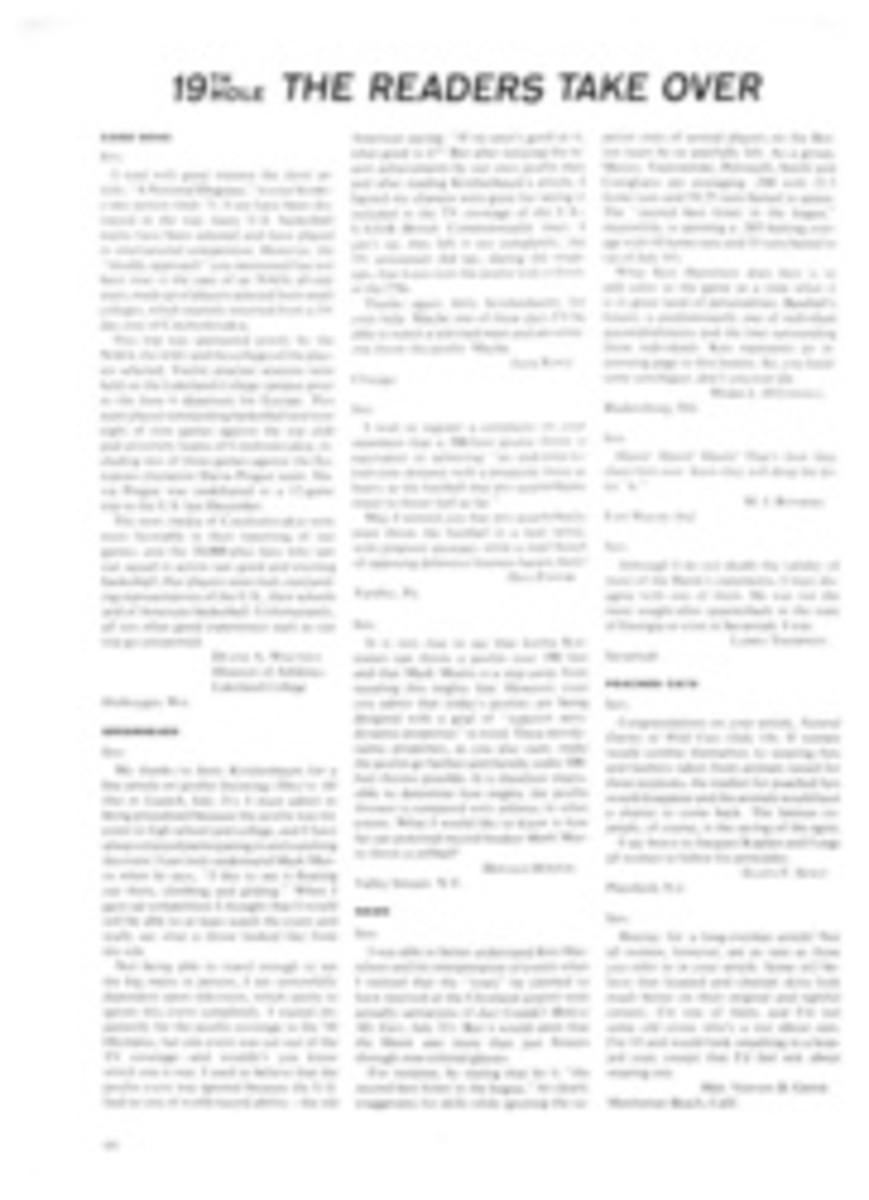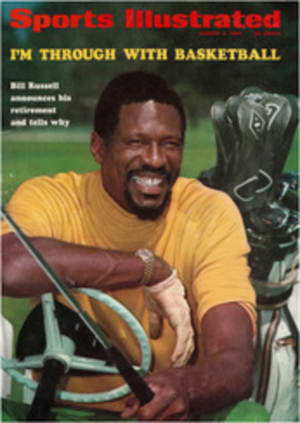
This is one stag who can outrun the hounds
The history of marathon running is built around the careers of little fellows who would look more at home on the backs of racehorses. The men best designed to tackle the marathon's double-barreled challenge of pace and distance are those who travel light, and the rule of the race has always been that a good little man can beat a good big man anytime. Now along comes a relative giant named Derek Clayton who breaks all the rules—and the records. Clayton, an Irishman from Belfast who currently lives in Melbourne, Australia, is 6'2" tall. Most of Clayton's competition is six to 10 inches shorter, and when he runs, the image evoked is that of a huge stag pursued by snapping beagles.
The ending is usually happy, however, because Clayton may be the best marathoner currently slap-slap-slapping rubber to asphalt. He has won seven of his 10 races and is the only runner ever to cover the marathon's 26 miles, 385 yards in under two hours, 10 minutes. And he's done it twice. Marathon courses differ so widely that world records are never official but, official or not, the fastest-ever time of 2:08:33 that Clayton set on May 30 in Antwerp averages out to an impressive 4:54 per mile. Last week in the British marathon championship at Manchester, Clayton finished second in the good time of 2:15:40. He is not the sort to offer excuses, but the race was held on a very hot and humid day and Clayton had recently returned from a two-week tour of Scandinavia.
It seems ludicrous to speak of natural-born marathon runners (the event is so unnatural), but if there is such an animal Clayton must be it. The key to his success is a daily training ordeal that most runners couldn't cope with once a week. "If your aim is to run five-minute miles in a race," Clayton says, "then it's no good doing six-minute miles in training." The training grind with which he regularly fustigates himself has produced some bizarre experiences. Complete collapse and a comatose state lasting 30 to 45 minutes is routine. Finishing up one 32-mile run at flat-out race speed on a hot, humid summer day, Clayton ran full tilt into a tree. "I could see the tree coming all right," he recalls. "But the message didn't get from my brain to my legs fast enough."
Ron Clarke, a Melbourne neighbor, says, "Running is fun for most of us, but for Derek it's an obsession. There is no one who can drive himself the way he does. He'll run with my group for 18 or 20 miles on Sunday morning and in the afternoon, while the rest of us are recuperating on the beach, Derek is back out there on the road thrashing himself through a much faster, harder 15-mile run."
Ordinarily anyone who treated each daily training run as if it were an Olympic final would be burned out before the target even came within range, but this may be where Clayton's size works to his advantage. "I used to go along with the myth that a big man could never be successful at the marathon," he says. "Now I know the opposite can be true. A big man is capable of doing much harder training than a small man. Because of his strength he's also able to fight through the pain that would cause a smaller man to fold up."
Another factor may be that since Clayton came late to running he still has years of enthusiasm left. As a kid growing up in Belfast he had no natural talent for the sports he liked: cricket, tennis, soccer. Even vocationally he shopped around: a short while as a draftsman, eight unhappy months in the Royal Air Force, a short term as a car salesman. "I didn't respect people who were failures," Clayton says, "and I began to think that I'd never respect myself if I didn't succeed at something."
The answer was to take up running the mile at 19 and then move to Australia with his mother and sister when he was 20. Clayton soon found happiness as a draftsman-surveyor and as a reasonably competent distance runner. In 1965 he won his first marathon, the Victorian state championship. But it was two winning races against Clarke that finally established his reputation as a world-class runner.
In August 1967 he beat Clarke in a 15-mile road race by over a minute, then the both of them entered the Australian marathon championship. "It was a lark, really," says Clayton. "Clarke entered, I think, because he was looking for a little revenge and figured he could toss me."
Clarke couldn't. Clayton won in a national record time of 2:21:58 and was named as Australian representative to the annual Japanese open marathon race in Fukuoka. Clayton trained hard for this event, which matches the best long distance road runners in the world, and in December 1967 he ran away from the field. His time stripped more than 2½ minutes off the previous world best. It was 2:09:36, an average of 4:56 per mile.
"I felt like a well-oiled machine," he says. "As if I were not running but simply sitting at the wheel of a Rolls-Royce. I was running fast, but it felt so great and seemed so effortless."
Clayton's emphatic performance in Japan made him, despite the hazards of Mexico City's 7,349-foot altitude, a strong pre-Olympic favorite. He took the role seriously. "I knew that altitude certainly wasn't going to help me," he says. "Runners trained at high altitudes were going to have an advantage. I decided I would work so hard that I would overcome that advantage." Each morning at 6, Clayton rose at the clang of his alarm clock, sipped hot water, did calisthenics and walked around the dining room table until he felt sufficiently loose and awake to embark on a six-or seven-mile run, done at a six-minute per-mile pace. Each evening after work he would undergo his really serious training of the day, a run of 15 or 20 miles at race speeds of 5 to 5½ minutes per mile. Each Saturday afternoon he would cover a full marathon distance—alone naturally—in a time of 2½ hours or less. Sunday morning he ran with Clarke and Sunday afternoon he ran alone. Total mileage was between 175 and 220 miles per week, much at nearly full throttle.
"The strain and the pressure were fantastic," Clayton recalls. "I was heading for physical and mental breakdown. I dreaded my evening workouts because I'd decided each one had to be really painful to do me any good. I dreaded my morning workouts not just because it takes me so long to get going in the morning but also because it was winter in Australia and always cold and dark. Very often at night I dreamed I was basking on the beach of a palm tree-covered island with no worries and nothing to do but rest. Then the alarm would go off. I knew I had to decide quickly about getting out of bed or I'd just lie there and blow the workout. After a while my brain began to feel as if it were getting tight, like a cramp. I used to lose my temper a lot, snap at people. After an evening run I'd often be too stunned to even move for half an hour. When I recovered I was usually too restless to read or watch television. What I really wanted was to be completely alone. It looked like I'd crack up mentally first."
It must have been a pretty close race, but physical crackup reached the tape in front. Two months before the Olympics, Clayton developed a cyst on the cartilage of his right knee. It caused pain, stiffness and swelling. Doctors examined the knee and declared that he needed an operation. "Sure I needed an operation," says Clayton, "but that would be giving the Games away. I told them I'd run even if it meant losing the leg."
By the time the teams began assembling in Mexico City Clayton was among the walking wounded, and on the few occasions when he tried to train, the knee swelled up to the size of a grapefruit. Nevertheless, on race day Clayton was on the starting line, his knee filled with pain-killing injections. For the first hour he couldn't even feel that he had a leg at all. Thereafter, when the dope wore off, he felt every painful twitch and twinge. Still he limped in, a very creditable seventh, only seven minutes behind winner Mamo Wolde of Ethiopia.
After returning to Melbourne Clayton had the cartilage removed, and by last January he was able to do light jogging. In March he resumed heavy training and in May he was back, breaking world marathon records again.
Before the recent British marathon championship, Clayton eased off heavy training. He toured Scandinavia with Clarke and ran in a number of 3,000-, 5,000-, and 10,000-meter races, barely a workout for him. This hurt at Manchester, where he finished two minutes behind Ron Hill, one of those jockey-size runners. Undertrained as Clayton was, he kept flogging himself in an effort to overtake Hill. For the last 10 miles he was in a virtual coma, and at the finish his eyes felt as if they were filled with sand (a classic symptom of dehydration) and his stomach as if it were filled with writhing snakes (symptomatic of just about anything). For 45 minutes Clayton lapsed into one of his postworkout, semiconscious states.
"I think you could say he'd overextended himself," said the doctor who examined him later, a smile emphasizing the understated assessment. "But my God, he's strong as a horse. He could run the race all over again in 48 hours."
PHOTO
LIKE AN AMBLING TOWER, Clayton strides purposefully ahead in the British marathon. Undertrained for race because of a Scandinavian tour, he wound up second behind little Ron Hill (54).

